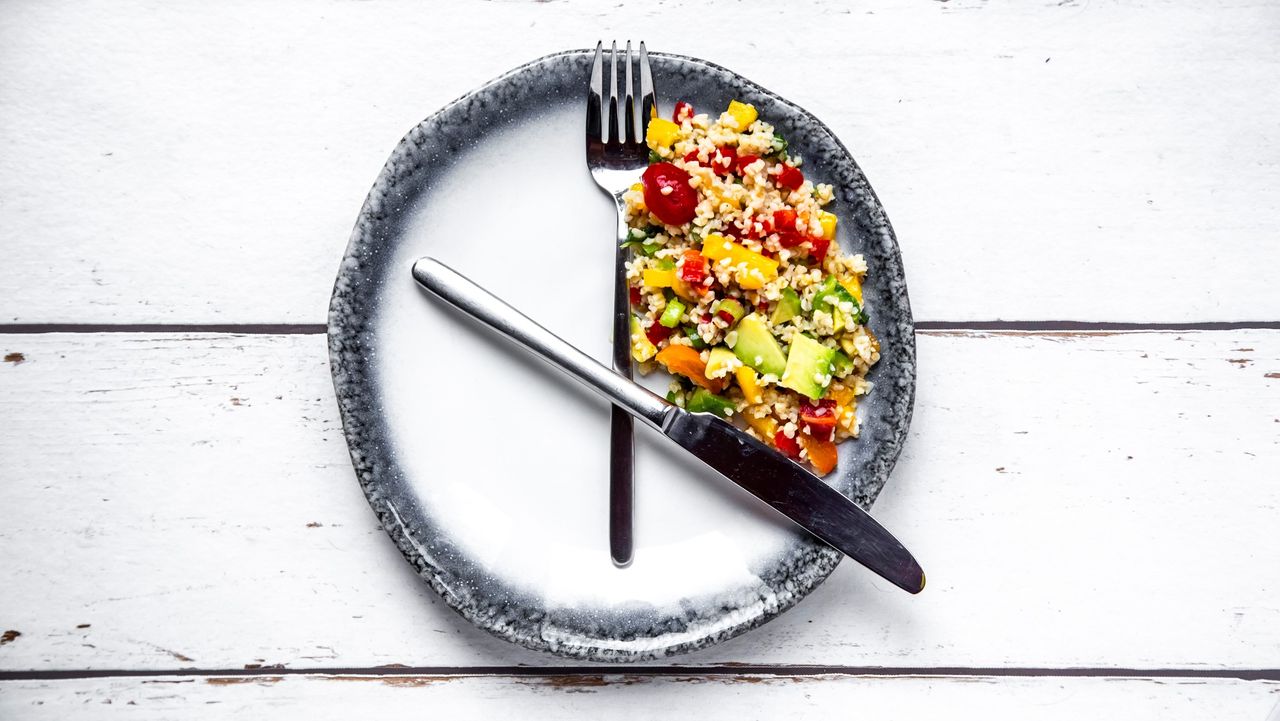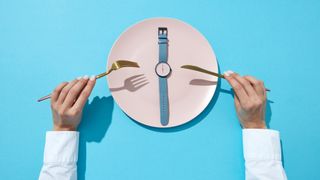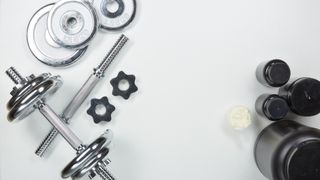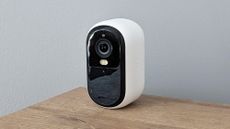

In this article, we'll try to explain the basics of how to lose weight with fasting and also touch on what fasting is in the first place, is fasting safe, what can you eat when you fast and provide you with some fasting tips on how to start this type of diet, even today. It'll help you get fit in 2020.
We can assume two things about people reading this article:
1. You are interested in fasting
2. You would like to lose some weight
The most popular type of fasting for weight loss is the 16:8 diet, but the principles can be applied in various ways. We also recommend reading our story on how to lose weight, which provides you with some handy tips about the topic. Let's not forget, we also covered the keto diet, as an alternative.
Exercising is also a great way to lose some excess weight and – you've guessed it! – we have things to say about that, too: we can help you to get into running with some super couch-to-5k training tips as well as resistance training plans, like our two-day push-pull plan or you can also try our beginner callisthenics workout plan.
Without further ado, let's get right into it.
IMPORTANT: if you have a history of eating disorders, have loads of extra weight, are pregnant or just concerned about starting fasting in general, please consult your doctor before you start fasting. it is always better to be safe than sorry, especially when it comes to health-related issues. Also, children are not advised to fast. Please be sensible.
Sign up to the T3 newsletter for smarter living straight to your inbox
Get all the latest news, reviews, deals and buying guides on gorgeous tech, home and active products from the T3 experts
- Which fasting method is best for weight loss? Science has the answer
- What are macros for weight loss
- How to avoid weight gain at home

Fasting is a type of cyclical diet regime
What is fasting?
To clarify, when we talk about fasting here, we mean intermittent fasting. Intermittent fasting is a cyclical calorie intake routine that alternates between periods of no food intake (a.k.a. fasting) and periods of calorie consumption (any other time outside the fasting period).
• Lose weight at home: avoid these 5 types of food if you want to drop weight fast
The most popular way of fasting is the 16:8 diet method, when you fast for 16 hours and only eat in an 8-hour window. There are other fasting techniques, such as the 5:2 diet, where people largely – but not entirely – skip eating for two days during the week. There are also more extreme versions, which we don't recommend.
• Is weight loss faster if you add a fasting diet to cardio?
Fasting has been scientifically proven to be a useful tool for lose weight, if for no other reason, because you naturally eat less if you restrict your consumption for fewer hours a day. This will also give your body time to repair, since it's not preoccupied with the digestion and storage of food.
- Weight loss with the 5:2 diet: requires willpower but can be powerfully effective
- Workouts for women: all our best weight loss and exercise advice, gear and more

A balance diet is still very important, even if you aren't planning on fasting
How to start fasting
The most popular way of fasting is the aforementioned 16 8 diet method. This way, you reduce your calorie consumption window from infinity to 8 hours a day. For the remaining 16 hours, you can still drink water (and you should drink water, plenty of it), black coffee and green tea.
The easiest way to get into fasting is to introduce the concept to your body gradually. By not jumping right into it, you are more likely to stick with it and turn it into a habit, which will help you effectively keep down the lost pounds.
Start off by not eating anything from 8 PM until 8 AM the next day. With this, you are already limiting yourself to eat only for 12 hours a day, and even better, you will sleep through most of it.
Over a period of a week or two, gradually increase the fasting window from 8 to 12 hours, by adding an extra hour in either in the evening or the morning. The most common way is to do a 16-hour fast is to stop eating at 7-8 PM and finish it at 11 AM-12 PM the next day.
You can start fasting at any point, no need to wait until the 1 January. The sooner you start the process, the earlier you will see results. Easy as that.
- Huel is not a diet or a protein shake; it's a food replacement system in shake form. Here's what you need to know...
- Plenny meal replacement bar wants to take a bite out of Huel and Soylent
- We sampled the new vanilla flavoured ready-to-drink Soylent meal replacement drink and it actually tastes GREAT

Avoid processed food, bad carbs, unhealthy fats and added sugar
What can you eat during fasting
It is recommended not to take in any calories during fasting, only liquids. Water is something you should drink anyway, but it is especially important to drink plenty of water when you fast. Black coffee and green tea are also permitted during the fasting phase, but don't overdo them. They both contain caffeine so over-consumption can lead to unwanted side effects.
As for outside the fasting window, there is no restriction of what you can or cannot eat, but it is recommended to avoid processed and fast food as well as excessive alcohol consumption. In general, try not to cut back on calories too much, especially at the beginning, to help your body adjust better.
Once you used to fasting, you can introduce other changes in your diet, like avoiding added sugar, food with high glycemic index, bad fats and so on. Try to plan ahead on what will you snack on when cravings arrive, because they will most definitely come at some point during the day. Protein and nutrition bars are a great way to combat cravings throughout the day.

Fasting is safe, especially if you don't go crazy from Day 1 (or ever)
Is fasting safe
Fasting is safe as long as you don't overdo it. If someone go from a high-calorie and high-sugar diet to not eating for 16 hours, they will feel dizzy and jittery, due to the withdrawal effects from their previous dieting habits.
As with any diet, be sensible when you start fasting. As mentioned above, try gradually increasing your fasting window and try not to cut too many calories from one day to another. By not eating for 8-12 hours, you will naturally take in less calories, without any other restrictive factors.
Once you are comfortable with fasting, you can try and switch to healthier diet overall. The key is, as before, to be unhurried with the process, and swap bad things out one at a time.
For example, instead of having a Mars bar, have a protein bar in the afternoon or instead of having a triple shot vanilla latte with extra cream after lunch, have a smaller cappucino. And of course, instead of having a side of fries, have some baked potatoes or even better, baked sweet potatoes.
By cutting added sugar out of your diet, you can also avoid the highs and lows you feel when you eat the sweet white substance. We'll discuss this in another article.

Start with some light exercising at the beginning
Can you work out when fasting
It is safe to work out after the initial transition period.
It is not recommended, however, to start working out heavily as soon as you start your new fasting diet. This is especially true to people who go from a high-sugar diet to fasting. The withdrawal symptoms from taking less sugar is not a safe way to start working with heavy weights.
Light exercising is permitted even at the beginning, let it be some jogging or easy cycling. Again, it is important not to put your body under too much stress.
If you are planning on gaining muscle mass, you can still benefit from fasting, but probably not the 16 8 diet method. You might want to try going a day or two without eating a week, to rid your body from toxins. Ideally, fast on your rest days so it won't effect your performance in the gym.
If you would like to work out on fast days, take some BCAAs to aid muscle repair. BCAA powders and pills contain no calories and therefore won't break your fasting period. Needless to say, mix it water and not milk or milk substitutes.
Supplements like creatine and Nitric Oxide pills (a pre workout that contains no stimulants) are also safe to consume during fasting since they contain no calories either.
- Best cheap protein powder deals: bulk up with whey and vegan powders without slimming down your wallet
- Best cheap creatine deals: boost your performance and focus with cheap creatine monohydrate
- Best cheap pre workout deals: Push more and focus better with the best (and cheapest) pre workout supplement deals
How to lose weight with fasting: summary
Fasting is an excellent way to lose weight and to rid your body of toxins. Even better, you naturally lower your calorie intake by not allowing yourself to eat whenever you want to. This can not only help you lose weight without much effort, it will also help you practice some discipline over your own body, keeping your mind in control over your cravings.
As with all dieting methods, being sensible is key when it comes to fasting. Don't try to change everything too fast; allow your body to adjust to the different requirements. If you would like to further aid your weight loss, you can also introduce some light exercising when you begin fasting, like easy jogging or light cycling, which in turn will also release serotonin on your body.
At the end of the day, it is all about achieving and maintaining a balanced lifestyle and bodyweight and reap the long term benefits of being happier and healthier.

Matt Kollat is a journalist and content creator who works for T3.com and its magazine counterpart as an Active Editor. His areas of expertise include wearables, drones, fitness equipment, nutrition and outdoor gear. He joined T3 in 2019. His byline appears in several publications, including Techradar and Fit&Well, and more. Matt also collaborated with other content creators (e.g. Garage Gym Reviews) and judged many awards, such as the European Specialist Sports Nutrition Alliance's ESSNawards. When he isn't working out, running or cycling, you'll find him roaming the countryside and trying out new podcasting and content creation equipment.
-
 Xbox Game Pass getting the mega remake I've wanted for two decades for free
Xbox Game Pass getting the mega remake I've wanted for two decades for freePlayStation and Nintendo console owners will have to pay for it
By Rik Henderson Published
-
 Arlo teams up with Samsung SmartThings to expand its AI-powered security features
Arlo teams up with Samsung SmartThings to expand its AI-powered security featuresSamsung SmartThings users will love this new Arlo security upgrade
By Bethan Girdler-Maslen Published